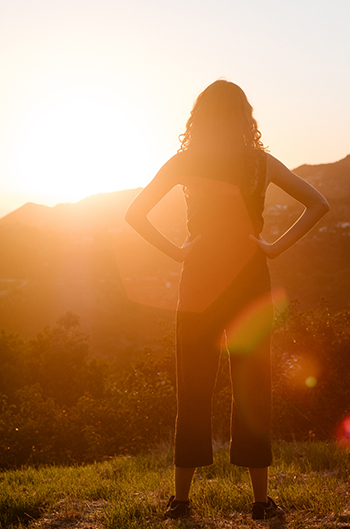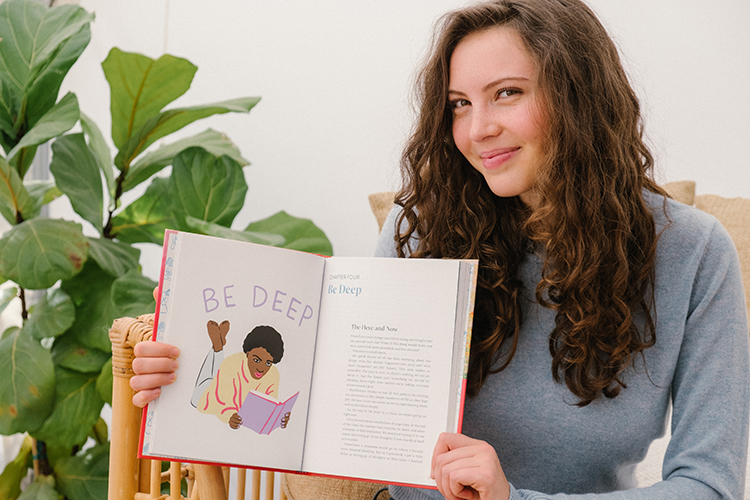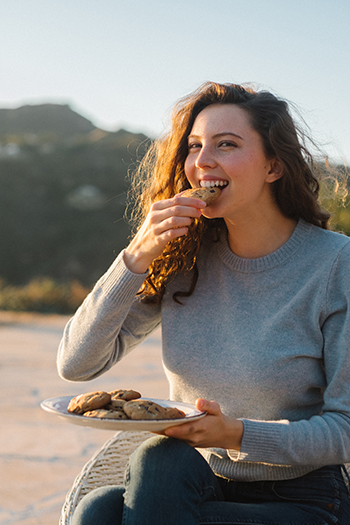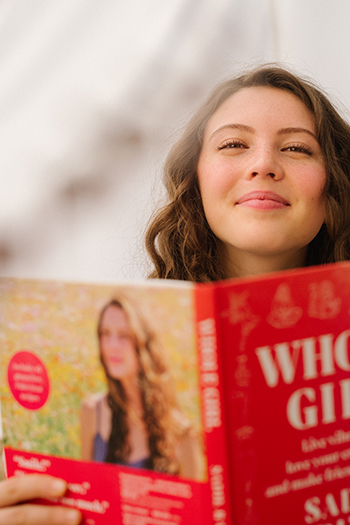Whole Girl: First-year student’s book aims to nourish girls, young women
Sadie Radinsky provides advice, gluten-free recipes and empowerment that stem from her own journey toward well-being
March 31, 2021

“Young women constantly are being criticized and told we’re not enough. But we are incredible just the way we are — strong, complex, and different,” UC Berkeley first-year student and teen writer Sadie Radinsky writes in her just-published book, Whole Girl: Live Vibrantly, Love Your Entire Self, and Make Friends With Food. (Photo by Jackie Radinsky)
In early February 2020, Sadie Radinsky was an elated high school senior: She’d been accepted to UC Berkeley, her top choice for college. But the 18-year-old was in an uncommon circumstance, with her first book on its way to publication. So, she considered deferring her enrollment for a year to be on the road, launching her book.
Then, the coronavirus pandemic hit, and Berkeley’s courses — and Radinsky’s book tours — turned remote. And Radinsky, who hasn’t yet declared a major but is leaning toward global studies, discovered she could attend both classes and public appearances for her book from her family’s home in Topanga Canyon, in Southern California’s Santa Monica Mountains.
Below, Radinsky talks about her just-published book, Whole Girl: Live Vibrantly, Love Your Entire Self, and Make Friends with Food, which is part cookbook, part self-help guide, and about her hopes for fall semester 2021, when she’ll see Berkeley for the first time.
On Feb. 9, she also had a piece published in the New York Times called “Baking as a Mindful Break From Zoom School: How making healthy treats helped me enjoy desserts again.”
Your new book is full of advice, practices and recipes for girls and young women who struggle with body image, identity and their relationship with food. It’s based on wisdom you gained from your own journey. When did that begin?

Suggestions for “Mindful Moments,” such as seated meditations and yoga poses, are part of Sadie Radinsky’s new book. (Photo by Jackie Radinsky)
Sadie Radinsky: It all began with food. When I was nine, I started getting stomachaches and fatigue every day, and they wouldn’t go away. My parents took me to many doctors, of all kinds, but none of them knew what the issue was. I missed more than half of fourth grade, and it was really hard — especially because nobody seemed to know what was wrong with me, and some doctors even said the issues were in my head.
My mom had started reading online that going gluten-free was helping lots of people with their health issues, so she asked the doctors about it. None of them thought gluten-free would help.
But we decided to try it anyway. I went completely gluten-free, and for the most part, the rest of my family did, too, because, that way, it was easier to cook. My family also started eating meat for the first time, since we’d all been vegetarians previously, and that gave me so much more energy and vitality.
Soon, my symptoms started to ease up. After two months of being off gluten, all the symptoms were completely gone.
Is this when your love of gluten-free baking began?
I baked a little with my mom when I was younger, but we mainly made savory foods, her specialty. So, the only dessert recipe I’d ever created was a cake made from mayonnaise, sparkling water, and baking soda … let’s just say I’ve upped my game a bit since then.
My obsession with baking really began when I went gluten-free. At the time, there were no good gluten-free desserts and baked goods in stores. But I’ve always loved desserts and sorely missed them. So, I started baking my own.
I started by making recipes I found online and did this for about two years. But soon, I got restless making other people’s recipes and wanted to create my own. I started getting creative with ingredients and flavors and textures, scouring farmer’s markets for new produce to incorporate into my desserts.
My family loved this new obsession of mine because I was shoveling a constant stream of freshly-baked desserts at them. They were all very surprised at how good they tasted. Even though they were grain-free and super low in sugar, they were rich and flavorful.

Sadie Radinsky’s book encourages girls and young women to embrace feelings that society can be critical of, like being bossy, blue, mad, wild and deep. (Photo by Jackie Radinsky)
As you got a little older, what did you begin to observe about the relationship many girls and young women have with food?
Soon after going gluten-free and discovering the joy of baking, I entered middle school. In those years, I noticed a shift in the way the girls felt about food. Food suddenly became filled with shame. At lunch time, some kids would deprive themselves by eating a small salad even when they were hungry, or by skipping lunch entirely.
I slowly realized that our changing relationships with food were due to the way our society talks to girls about food. It comes from every facet of our culture—from TV shows, advertisements, even our families.
I hadn’t really been exposed to negative messages about food before, largely because I grew up without media. I never had TV or a phone as a kid, so I never saw the messages that constantly pit women against food and their bodies. It made me angry to see how our culture turned food —a not only necessary, but also quite beautiful, part of life, into something scary and shameful.
I wanted to create a place where we young women could come explore baking and eating delicious, healthy food.
Also, around that time, a lot of other young women and mothers I knew had started going gluten-free due to various health issues, and they kept asking me for the recipes for my desserts. So, when I was 12, I started a little blogspot.com website called Goodies Against the Grain, where I posted the recipes. My mom took all the photos of my concoctions, and it was a super creative process. I began sharing not only the gluten-free recipes, but also blog posts about food and well-being for young women.
Since then, it has grown into my website wholegirl.com and my book Whole Girl.
When did you get the idea for a book?

Sadie Radinsky began creating recipes for healthy, gluten-free desserts in the 9th grade after suffering in prior years from stomachaches, which eased with a gluten-free diet. Several dozen recipes are in her book, which was published last month. (Photo by Jackie Radinsky)
When I entered high school, an idea started to blossom in my mind: I wanted to create a book for young women focused on fueling and nourishing every part of ourselves, mentally and physically. So much of the messaging we ingest as teens encourages us to deprive ourselves —whether it’s shaming us for being bossy or mad, taking up space in the world, not smiling enough, talking too much … the list is infinite.
I wanted to write a book that was instead focused on embracing and celebrating every part of ourselves. All the messiness, all the moods, all the power.
So, each chapter of Whole Girl focuses on a different emotion — like Be Bossy, Be Blue, Be Mad, Be Wild — and is filled with empowerment practices and tips, mindful movement exercises and, of course, gluten-free treat recipes.
To me, food is a huge part of embracing and loving ourselves. Just like we’re conditioned to not take up space in the world, we’re conditioned to feel guilt around food, especially desserts. So, baking and eating delicious, feel-good treats is an act of self-care — and a bit of a rebellion. It’s also a wonderful way to nourish ourselves.
What kind of reaction are you getting to the book?
Whole Girl just came out Feb. 2, the day before I turned 19. It has been getting really positive feedback from girls of all ages, which is incredible to see. I wrote it with especially teen girls in mind, but I was also hoping that younger girls and older women would relate to it, too — and it turns out, they are.
One of the most incredible things to come out of the book release has been these deep connections I’ve formed with young readers. For example, last month I got a message from a mother in New Jersey whose daughter has been having stomach issues and missed half of the fourth grade (the exact same age that this happened to me), and that she recently had to go gluten-free. This girl has discovered my book and fallen in love with baking the recipes. The mother started sending me photos every day of her making my treats. Just a few weeks ago, we had a FaceTime so she could interview me for her International Women’s Day presentation at school. Now she wants to write a book, as well, when she is older, and has already started creating her own recipes.

Sadie Radinsky, 19, has been juggling virtual book tours and her studies at Berkeley during the pandemic, and she’s already at work on a second book. (Photo by Jackie Radinsky)
What’s it like to do a Zoom book tour?
I had no idea what to expect going into a virtual book tour. I was a little nervous before my first event, a workshop on Zoom with the amazing Banyen Books in Vancouver. I was expecting about three people to show up, so I was surprised and elated when a huge crowd joined. I taught the audience how to make homemade dairy-free yogurt from the book, then gave a talk on listening to our gut. It was such a fun experience — so different from anything I’ve done before, which made it terrifying, but also really gratifying because I was able to talk in-depth with a large group of people about the issues I care about.
I’m really enjoying the virtual book events because they allow people from all over the world to join for free, while supporting independent bookstores. It feels like a very accessible and welcoming format. Hopefully I’ll be able to do in-person talks in the not-so-distant future, but for now, this is a really cool experience.
Any thoughts about your upcoming sophomore year at Berkeley — finally being on campus?
I am ridiculously excited to come up to campus in the fall. I’ve never been to visit the school before, and I am excited to explore it, and take classes in person, meet new people … everything.
I am especially looking forward to experiencing the food scene on campus. I want to take classes from different professors on food and food systems and agriculture — not to mention eating all the food the city has to offer. I think my first stop when I get up to campus will be scouting out all the local grocery stores.
Has your first year at Berkeley and your experience writing this book inspired any future goals?
I have a concept for a second book that’s currently in the works, and several other projects. I’m also looking forward to living in Berkeley and soaking in the food world there, and seeing where that takes me.
I think that as a freshman, and even when we’re older, it’s really hard to plan out our lives — especially in a time like this, when we can’t even be certain of what the world will look like tomorrow. So, I’m trying to get more comfortable with the unknown. I think that moving up to Berkeley for the first time and experiencing this new part of life will bring me opportunities I haven’t yet imagined, so I am going to stay open to all different possibilities.